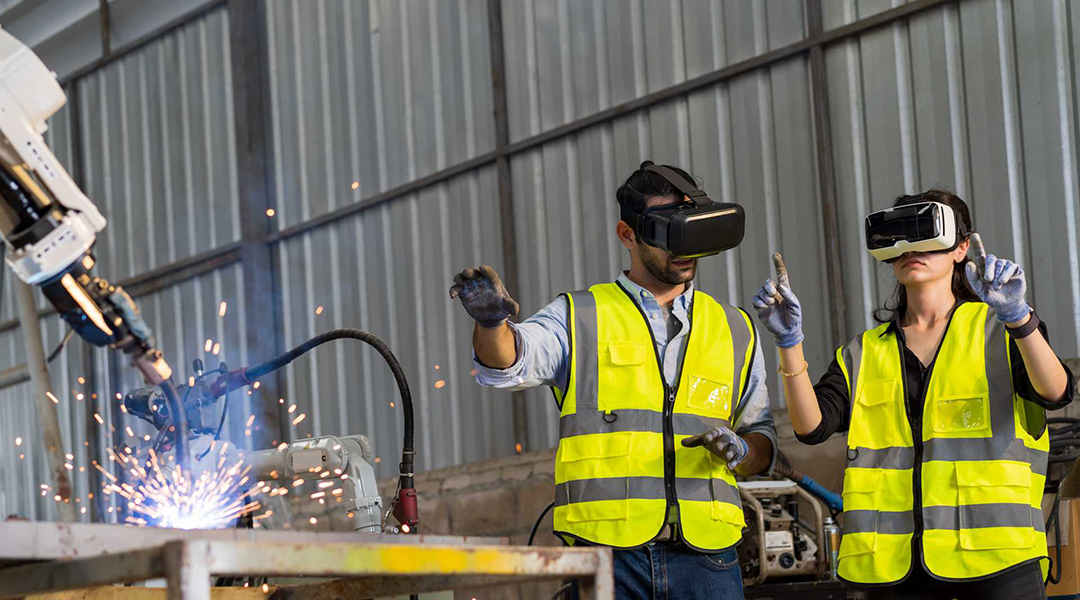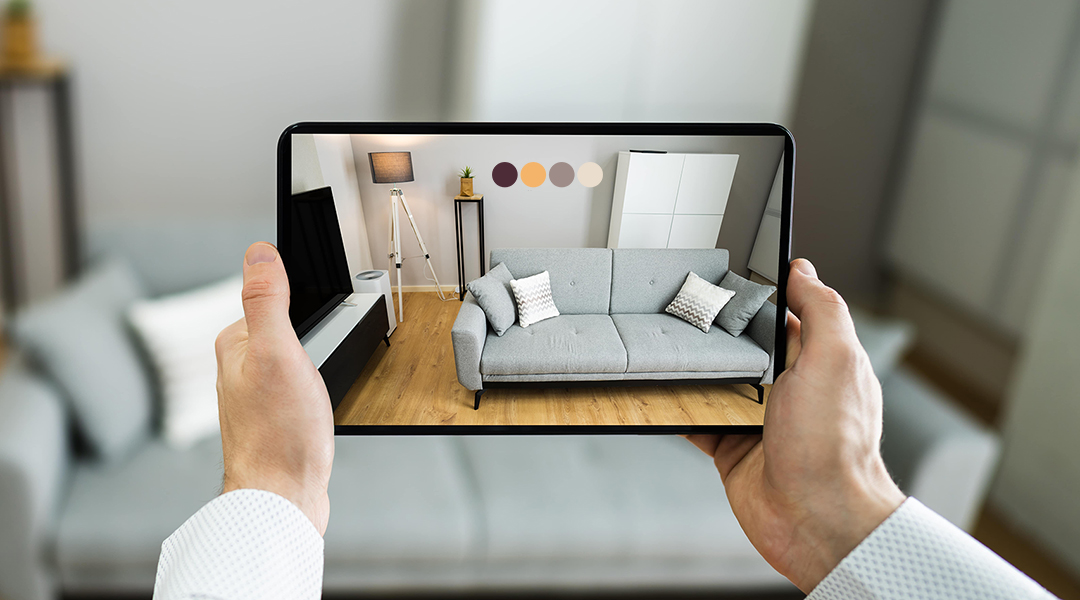When first introduced, augmented reality made a splash and brought a new dimension to humanity's interaction with the digital world, primarily through the development of augmented reality apps. Now, with the continuous development of the technological landscape, augmented reality apps have become a technology that users have become accustomed to. However, the impact of this tool has never been as substantial as it is now. Moreover, experts predict further augmented reality market growth, especially in the augmented reality app sector, with a whopping CAGR of 50.7% by 2030.
With multiple industries choosing to implement augmented reality through augmented reality apps, the demand for building AR-powered applications is enormous. More and more software vendors add augmented reality app development to their service cards, increasing the number of diverse AR applications on the market. Program-Ace, an experienced augmented reality app development company, created this article as a complete guide for companies planning to tap into the AR sector and build an AR app.
What Is Augmented Reality?
An augmented reality (AR) app is an immersive technology that blurs the line between the physical and digital worlds, enhancing our perceptions and interactions. Unlike virtual reality (VR) apps, which create an entirely virtual environment for users, an AR app overlays virtual objects in the real-world environment, enriching the user's interaction and understanding of the world around them.
The concept of AR apps is not new, but their recent surge in popularity can be attributed to advances in processing power, device miniaturization, and network capabilities. With an AR app, digital elements such as images, sounds, 3D models, and videos are superimposed on the real world to generate a composite view. This augmentation can be experienced through various devices like smartphones, tablets, smart glasses, and AR headsets.
AR apps can provide value across a wide range of applications and industries. For example, an augmented reality app can turn the surrounding environment into a digital playground in gaming. This was demonstrated by the worldwide phenomenon Pokémon Go, where players catch virtual creatures in real-world locations. In the retail sector, an augmented reality app can enable customers to visualize products in their own space before making a purchase decision. Think of trying on clothes virtually or seeing how a piece of furniture looks in your living room using an augmented reality app.
Building a world-class quality augmented reality app requires a comprehensive understanding of this complex technology. There are numerous considerations, from designing compelling and intuitive user interfaces to handling the technical challenges of AR apps, such as tracking the user's environment and managing the overlay of virtual objects. While the process can be daunting, the potential rewards are considerable, with the global AR market size projected to grow substantially over the next few years.
Augmented reality apps represent a significant leap in how we interact with the digital world. By seamlessly integrating digital information with our physical environment, an AR app provides a richer, more interactive, and more personalized user experience. As we move into the future, the prevalence and impact of augmented reality apps will only continue to grow, making it an essential consideration for those looking to stay on the cutting edge of digital innovation.
Why Have Augmented Reality Apps Become Popular?
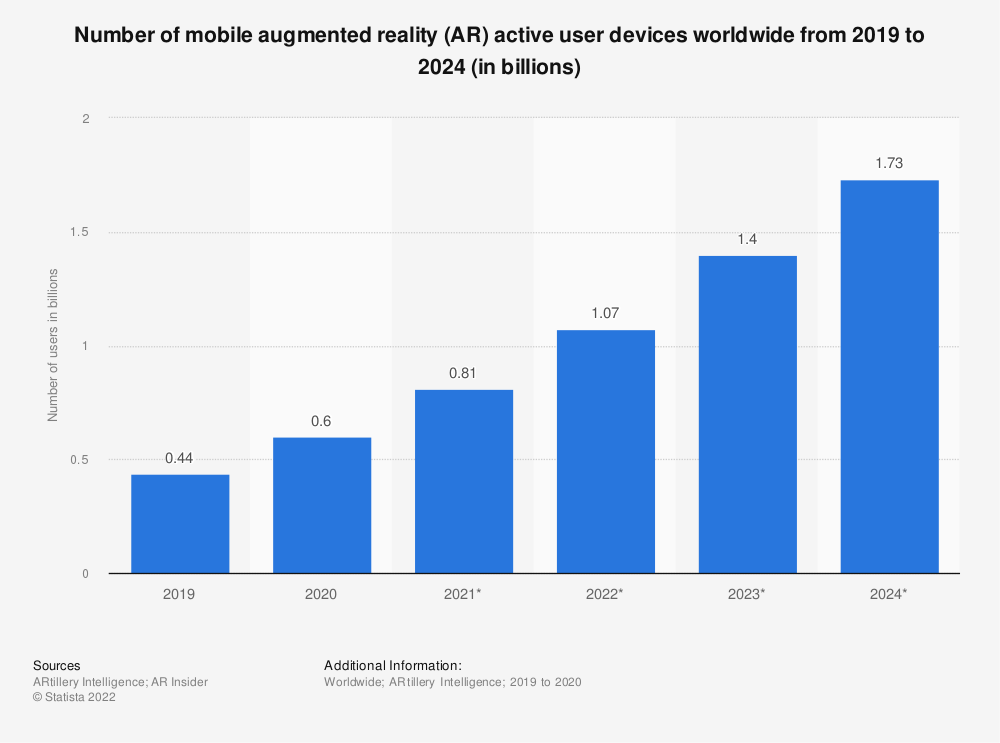
The popularity of augmented reality apps can be attributed to several pivotal factors, each contributing to this innovative technology's unique appeal and efficacy in today's digitally-centered world.
The widespread accessibility of smartphones and tablets capable of supporting AR experiences, specifically augmented reality apps, has been a critical driver. Over the past few years, advancements in processing power, sensors, cameras, and display technology have transformed our mobile devices into powerful platforms for building an augmented reality app. This means that AR is no longer confined to expensive and specialized hardware but is readily available to anyone with a modern smartphone or tablet equipped with an augmented reality app.
A significant game-changer in the quest to build an AR app has been the advent of AR development frameworks, like Apple's ARKit and Google's ARCore. These platforms have enabled developers to create augmented reality apps, facilitating a quick and cost-effective way. They provide tools that handle a lot of the heavy lifting, such as motion tracking, environmental understanding, and light estimation. This makes the process of how to build an AR app more accessible and less resource-intensive.
User experience is another crucial factor when considering how to build an AR app. AR offers a level of interactivity and engagement that's difficult to match with traditional apps. By blending the physical and digital worlds, augmented reality apps can provide more immersive, intuitive, and contextually relevant experiences. This can increase user engagement and retention, providing significant competitive advantages in fields like e-commerce, gaming, education, and beyond. The question of how to build an AR app that is engaging and user-friendly is thus a significant area of interest for businesses.
Being seen as innovative and cutting-edge can help companies stand out in crowded markets. By leveraging AR through building an augmented reality app, businesses can showcase their commitment to leveraging the latest technology to improve customer experience, which can be a strong differentiator. Therefore, a critical competitive factor is understanding how to build an AR app that aligns with a brand's image and customer needs.
Another factor behind the popularity of augmented reality apps is their potential to solve real-world problems and enhance various aspects of life and work. Building an AR app can make complex concepts easier to understand in education by providing 3D visualizations. Building an AR app in retail can eliminate the guesswork of online shopping by allowing customers to visualize products in their space. Building an AR app in healthcare can aid in tasks ranging from patient education to complex surgeries. The wide-ranging applicability of augmented reality apps contributes to their growing popularity.
The success stories of pioneering augmented reality apps have stimulated interest and adoption. The viral success of the augmented reality app Pokémon Go demonstrated the mass appeal of AR and opened the floodgates for investment and development in the field. Subsequent success stories in diverse sectors further confirmed the potential of augmented reality apps, fueling their continued growth and popularity.
The Future of Augmented Reality
As we look towards the horizon, the future of augmented reality apps shines with unbounded potential. They are poised to transform various sectors, impacting the way we work, play, learn, and connect with the world around us.
One of the exciting aspects of the future of augmented reality apps is the development and widespread adoption of wearable AR devices. While smartphones and tablets currently dominate the AR space, the evolution towards more immersive and hands-free experiences via AR glasses and headsets is underway. Companies like Apple, Google, and Facebook invest heavily in these technologies, promising a future where digital information and experiences through augmented reality apps are seamlessly integrated into our physical environment.
AR apps are also set to play a crucial role in the advent of the metaverse — a collective virtual shared space created by the convergence of physical and virtual reality. Here, augmented reality apps could enable users to interact with this space without being completely detached from the real world, enriching our interactions with both the physical and digital worlds.
AR in Manufacturing
In the industrial sector, AR is expected to revolutionize workflows. Using AR glasses, workers can access real-time data, receive remote assistance, and get detailed, step-by-step instructions overlaid onto their field of view. This can significantly improve efficiency, reduce errors, and facilitate on-the-job training.
AR in Education
Education is another field where AR's future looks exceptionally bright. AR can make learning more engaging and interactive, helping students grasp complex concepts by visualizing them in 3D. As AR technology becomes more integrated into classrooms, we can expect a shift towards more experiential and personalized learning.
AR in Retail
The retail sector is also set to benefit significantly from AR advancements. From virtual try-on experiences to in-store navigation, AR is expected to redefine the shopping experience online and in physical stores, building a connection between these two dimensions to engage customers in new exciting ways.
Despite these promising prospects, it's important to note that the future of AR also presents challenges. Issues such as privacy, digital overload, and the digital divide will need to be carefully managed. Additionally, creating compelling, intuitive, and contextually relevant AR experiences will require combining technical expertise, creativity, and a deep understanding of user needs and behaviors.
Overall, while it's impossible to predict the future with absolute certainty, it's clear that AR holds immense promise. By blending the digital and physical worlds, AR is poised to create a more interactive, immersive, and personalized future, transforming how we interact with technology and the world around us.
Main Benefits of Building an AR App
Augmented reality apps deliver a range of compelling benefits driven by their ability to blend the digital and physical worlds. These benefits can vary depending on the specific use case and industry, but several common advantages exist across the board. Let's delve into some of these primary benefits.
Enhanced User Engagement
Augmented reality apps provide a level of interactivity and engagement that's difficult to achieve with traditional apps. By overlaying digital information onto the physical world, augmented reality apps can provide a more immersive experience, keeping users engaged for more extended periods of time. This underscores the importance of knowing how to create augmented reality apps that are engaging and interactive, whether it's for gaming, where users interact with virtual objects in their real-world environment, or a shopping augmented reality app where users can visualize products in their own space. Comprehension of how to create these immersive experiences can increase user engagement and increase retention rates.Improved Learning and Training
Augmented reality apps can significantly enhance learning and training experiences across various fields. The ability to understand how to create augmented reality apps for educational purposes can bring complex concepts to life, making learning more engaging and memorable. In industries like healthcare and manufacturing, an augmented reality app can provide practical training tools, allowing workers to learn new skills or procedures in a safe, controlled environment. By creating a hands-on, experiential learning environment, an AR app can lead to better comprehension and retention of information.Increased Sales and Conversions
Augmented reality apps can directly increase business sales and conversions, particularly in retail and real estate. Knowing how to create augmented reality apps for these sectors can be beneficial. An augmented reality app enables customers to visualize products or properties in their own environment before making a purchase decision. This reduces the uncertainty associated with online shopping, leading to higher conversion rates, lower return rates, and increased customer satisfaction.Stand Out in the Market
Augmented reality apps can help businesses stand out in an increasingly competitive digital landscape. Businesses can differentiate themselves from competitors by leveraging the latest technology to provide innovative, value-added services. An augmented reality app can serve as a testament to a company's commitment to innovation and customer experience, enhancing its brand image and attracting tech-savvy customers.Efficient Information Delivery
Augmented reality apps can deliver information contextually and visually, making it easier for users to understand and act upon. AR can make information delivery more efficient and user-friendly, whether it's an augmented reality navigation app that overlays directions in the real world or a maintenance augmented reality app that shows technicians how to repair equipment.
Top Features Your Augmented Reality App Should Have
Building an AR application requires thoughtful consideration of the main features that can make your app stand out and deliver the desired benefits. While these features may vary depending on the specific use case, some are almost universally beneficial in creating an engaging and valuable AR app. Knowing how to create an AR app with these essential features can significantly enhance your project. We gathered the key elements to include when you build an AR app.
Robust Object Recognition
One of the foundational capabilities of an AR app is the ability to recognize and track objects and environments accurately. This enables the app to overlay digital information onto the correct parts of the physical world. Understanding how to create an AR app that can recognize a flat surface to place a virtual object, track the user's movement to adjust the view, or identify a specific object to provide relevant information is crucial for creating a smooth and immersive AR experience.
Real-time Performance
For AR apps to be truly immersive, they must perform in real time. Any lag between the user's actions and the app's response can break the illusion and create a frustrating user experience. Therefore, knowing how to create an AR app that's optimized for performance is vital. It should deliver fast and responsive interactions that keep users engaged and immersed.
User-friendly Interface
AR apps can deliver incredible experiences but can also be more complex than traditional apps. Therefore, it's essential to design a user-friendly interface that makes it easy for users to navigate and interact with the app. This might include intuitive gestures, clear instructions, and a simple, clean design that doesn't overwhelm users. Understanding how to create an AR app with a user-friendly interface is fundamental to its success.
High-quality Graphics
The quality of the virtual elements in an AR app can significantly impact the user experience. High-quality, realistic graphics can make the AR experience more believable and enjoyable. Whether it's a 3D model of a product, a virtual character in a game, or data visualizations in an educational app, investing in high-quality graphics can pay off in terms of user engagement and satisfaction.
Contextual Information
One of the strengths of AR is its ability to deliver contextual information – information that's relevant to the user's current situation or environment. By leveraging this capability, your AR app can provide more excellent value and a more personalized experience. This might include providing product information when the user scans a product in a store, offering directions when the user is navigating a new city, or showing repair instructions when the user is fixing a piece of equipment.
Cross-platform
Compatibility Given the diverse range of devices that can support AR, it's beneficial to design your app with cross-platform compatibility in mind. This ensures your app can reach a wider audience and deliver a consistent experience across different devices and operating systems.
Challenges to Be Aware While Building an AR App
To build an AR application, you must be ready to face a unique set of challenges. While the potential benefits are significant, developers should know these complexities to ensure a smooth development process and a high-quality end product. Knowing how to create an AR application that navigates these challenges is essential. Below are some of the most common challenges you may encounter while building your AR application.
User Experience Design
One of the biggest challenges in AR app development is creating an intuitive and engaging user experience. AR introduces a whole new dimension of interaction, and conventional UI/UX principles often don't translate directly. For instance, in AR, users can interact with the app using their movement and the environment, so the interface needs to accommodate these interactions. Building an AR app that balances novelty and usability requires extensive user testing and iteration.Performance Optimization
As we have already mentioned, an AR app demands high processing power and can quickly drain device batteries. Building an AR app that delivers real-time performance without consuming excessive resources is challenging. Knowing how to build an AR app that optimizes these resources is essential. Developers must ensure their apps run smoothly on various devices with varying hardware capabilities. This may require limiting the complexity of AR elements, efficient use of graphics and animations, and careful management of device resources.Device Compatibility
AR technology continuously evolves, with different devices offering different capabilities. Some devices may support advanced features like depth sensing and high-precision tracking, while others may not. Ensuring your AR app provides a consistent experience across different devices and operating systems can be complex and time-consuming. Understanding how to build an AR app that accommodates various devices is crucial. It may require you to develop multiple versions of your AR content to accommodate different levels of device capabilities.Tracking and Recognition
Accuracy in AR relies heavily on tracking the user's environment and recognizing objects accurately. Any inaccuracies can lead to a poor user experience, with virtual objects appearing in the wrong location or not aligning correctly with the real world. Despite advances in AR technology, achieving reliable, accurate tracking and recognition can still be a significant challenge, particularly in complex or changing environments. Comprehending how to build an AR app that handles these factors well is critical.Privacy and Security
AR apps often require access to sensitive data, such as the user's location, camera feed, and possibly other personal data. Ensuring this data is handled securely and complies with privacy regulations is critical. Furthermore, because AR apps can overlay digital information in the real world, they could potentially be used to share or display inappropriate or harmful content. Developers need to know how to build an AR app that implements measures to prevent such misuse and protect user safety.Content Creation
Creating high-quality AR content can be resource-intensive. It typically requires 3D modeling, animation, and possibly spatial audio. Depending on the complexity of the AR experience, this can require significant time, skills, and resources. Building an AR app that keeps its content up-to-date and relevant can be a continuous challenge. Delivering an AR app that incorporates a systematic approach to content creation is an essential skill for any AR developer.
How to Build an AR App
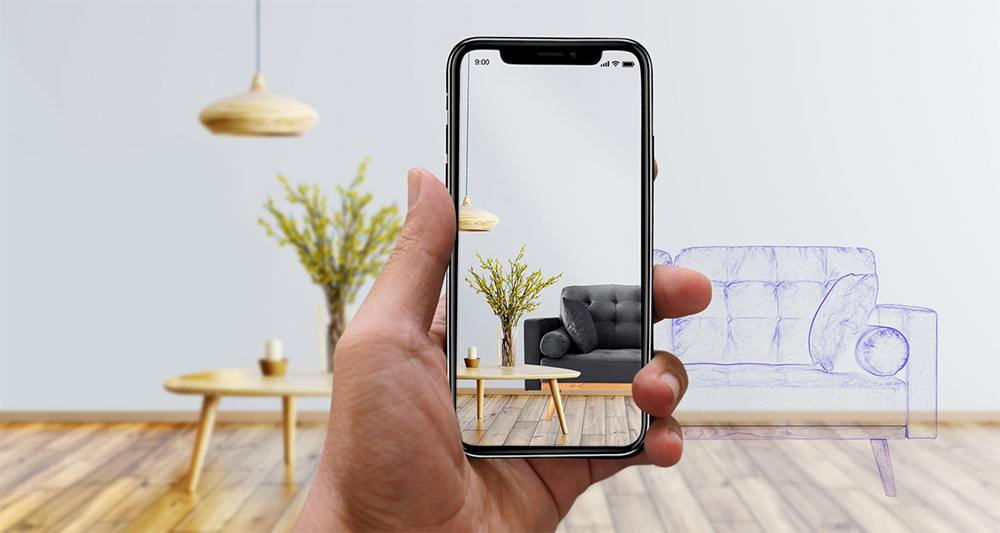
Building an AR application is a serious task and takes a high level of expertise and a long period of time. If you are a total stranger to software and languages such as Java & C++, we highly recommend hiring a professional or a team of experts to build an AR app. If not, you can also learn how to create an augmented reality app.
The first stage is to choose from the different tools/platforms that will help you build an AR app. Once you decide on the platform, you must decide on the application mechanism. There are multiple aspects to designing the perfect AR application. Still, broadly speaking, AR apps are built to work using either a marker-based or a location-based recognition system. After you have decided on the practical application of the AR app, here are some points to consider for its design.
- Do not keep the UI cluttered. It must be easy to understand and operate.
- Keep the hardware in mind. Make your app compatible only with devices that have the necessary hardware capabilities.
- Integrate the AR into the user's public and private environment.
- Keep user safety in mind when building an AR app. For instance, do not design the app to allow the user to move backward.
How to create an enterprise AR app?
When building an AR app for an enterprise, you must consider the problem the enterprise is looking to resolve with the AR application. The scope of the application and its practical implementations are the first and the most important things to consider.
For instance, if you are building an augmented reality app for healthcare for surgery assistance, you should make it highly precise and accurate by inputting all the body parts into its software.
How to make an AR game?
game developers have been looking to create their own AR success stories. To build AR games, you need a great concept and the right software to support immersive plugins.
Our tip is to ensure that the app you build supports only the devices with the necessary hardware capabilities since lagging and crashes with incompatible hardware show your creation in a bad light.
Delegate the development of your AR app to true professionals
Mobile AR Development: Choosing the Right Platform
If you are an augmented reality mobile developer, it can be tough to choose between developing augmented reality apps for Android, iOS, or both. How do you decide the right platform to build an AR app?
Android and iOS have helpful SDKs (software development kits), and selecting any OS is good. Ideally, you can pick a platform that lets you develop a cross-platform augmented reality app, providing greater depth and reaching a larger audience.
How to Make an Augmented Reality App for iOS?
You can create your iOS augmented reality app using ARkit. It's a robust framework that helps integrate motion tracking, light, camera scene capture, advanced scene processing, and more to build a comprehensive augmented reality experience for your iOS device. With its ARkit and comprehensive ecosystem, Apple makes building an AR app for its devices easy.
How to Create an Augmented Reality App for Android?
If you are an Android AR developer, ARCore is the basic augmented reality framework that helps build Android device apps. Mobile applications developed on ARCore work on Android and iOS devices, providing greater reach for your augmented reality app.
Cross-platform AR Development
Most third-party SDKs support iOS and Android augmented reality app development simultaneously. Choosing the right tech stack when you build an AR app is essential, and we recommend considering Unity, Wikitude, ViroReact, and a few other popular choices as a top priority.
Choosing the Right AR Stack to Build an AR App
Deciding on the right AR stack for your augmented reality app development pipeline is essential. This means selecting the right platform with all the required features and supporting plugins that you need to build a quality augmented reality app from square one.
How to Create an Augmented Reality App in Unity?
Unity is one of the most famous cross-platform AR app development SDKs. Its cross-platform compatibility, ample app size support, and interactive user interface make it one of the best platforms for this type of development. Fortunately, you can also create an augmented reality app using the Vuforia plugin in Unity for better tracking and recognition of 3D objects in real time.
How to Choose the Suitable SDK for Your Augmented Reality App?
Picking the suitable SDK is extremely important if you want to develop an augmented reality app across single or multiple platforms.
Here are some points you must remember when selecting the right platform for your augmented reality app. Ideally, it will support multiple operating systems, primarily iOS and Android. The more platforms it supports, the better it is for the users of your augmented reality app. Choose between the free and paid version of the product. We recommend picking a paid, licensed version for better features in your augmented reality app. It must support Unity, as it's one of the most advanced SDKs for excellent graphics in your augmented reality app. It should support cloud recognition. Cloud recognition ensures that your augmented reality app recognizes markers without taking up much space on the device. 3D tracking and recognition are most important for real-time triggers in your augmented reality app.
How Much Does It Cost to Build an AR App?
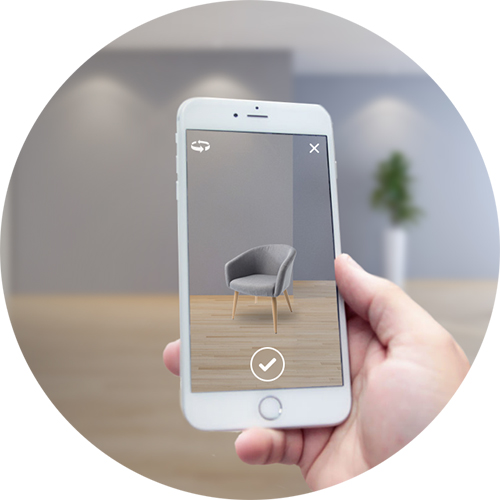
Determining how to build a cost-effective augmented reality app can be complex. The many variables involved, including the number of working hours, the scope of features in the augmented reality app, and the level of customization, can significantly impact the cost of an AR app. However, understanding these components can give one a clearer picture of the financial obligations involved. Our AR experts have compiled some essential elements that can influence the cost of developing an augmented reality app.
Conceptualization and Planning
The initial stage in understanding how to build an augmented reality app involves planning and conceptualizing. This includes identifying the augmented reality app's purpose, the target audience, and the key features it needs to incorporate. Preliminary market research and competitor analysis are also part of this stage. The costs associated with this phase primarily consist of human resources and time. They can vary significantly based on the complexity of the augmented reality app and the planning process's depth.
Design and User Experience
The design phase involves creating the look and feel of the augmented reality app, which includes the user interface and any virtual elements that will be part of the AR experience. Understanding how to build an engaging user experience and appealing design can influence the cost during this phase, depending on the complexity of the design, the quality of graphics, and the sophistication of the user interface. Although hiring experienced UI/UX designers can inflate costs, it often results in a more polished and user-friendly augmented reality app.
Development
The development phase typically accounts for the most significant portion of the cost. This is when the coding and building an AR app occur. The cost can vary based on factors such as the complexity of the app, the number of features, and the technology used. For instance, marker-based AR apps are usually less expensive to develop than markerless AR apps. The choice between native development (individual development for each platform) and cross-platform development can also impact the cost.
Content Creation
Understanding how to build an AR app requires a substantial investment in content creation. This could include 3D models, animations, videos, and multimedia elements. The cost will depend on the quality and volume of the content. Specialized skills such as 3D modeling or animation may be necessary, which could further increase the cost.
Testing
Testing is crucial in app development to ensure the augmented reality app functions correctly and provides a good user experience. This process includes testing the app on different devices under varying conditions and addressing any bugs or issues that arise. The cost associated with this can depend on the complexity of the augmented reality app, the number of testing rounds, and the severity of any issues needing resolution.
Maintenance and Updates
After building and launching the augmented reality app, ongoing costs for maintenance and updates will be incurred. This could include fixing any issues that crop up, adding new features, and updating the app for new OS versions, among other things. The cost can vary based on the frequency and complexity of the updates and any arising issues.
As illustrated, the cost of building an AR app depends on various variables, making it impossible to pinpoint an exact price without considering these details. However, based on our experience, we can refer to an average cost for typical AR development cases. Generally, it takes around 160 hours to build a simple augmented reality app, which costs approximately $5,000 to $10,000. The cost can significantly leap to between $70,000 and $100,000 for augmented reality apps rich in features and graphics.
We recommend outsourcing the development process rather than hiring an in-house developer due to the extensive experience that professional outsourcers provide in understanding how to build effective augmented reality apps. Furthermore, outsourcing is often more cost-effective as you save on software, human resources, and troubleshooting costs.
Get an estimation of your AR app from our experts
Monetization Strategies for Your Augmented Reality App
A robust monetization strategy is fundamental to creating your augmented reality app, as it determines the return on your investment and your solution's sustainability. Therefore, we suggest an early analysis of existing strategies and choosing one that aligns with your augmented reality app concept and guarantees the necessary profit levels.
In-app Purchases
In-app purchases are a prevalent strategy for monetizing mobile and augmented reality apps. This method offers specific features, content, or services within the augmented reality app that users can purchase. In the AR context, this could include unique filters in a social media app, advanced features in an educational augmented reality app, or additional levels in an AR game. To make this strategy successful, the additional content or features must offer substantial value to the user.
Premium Version
This model involves offering a free version of your augmented reality app with basic features and a premium version with additional advanced features. Users can test out the free version and upgrade to the premium version if they find value in the augmented reality app. While this model can be very effective, it requires careful balancing. The free version must be attractive enough to engage users but not so comprehensive that users see no incentive to upgrade.
Subscription Model
The subscription model is becoming increasingly popular as a monetization strategy for augmented reality apps. Users pay a recurring fee to access the app or specific features. This could be particularly effective for augmented reality apps that provide ongoing services or regularly updated content. For instance, an AR fitness app could offer personalized workout plans for a monthly subscription, or an AR learning app could provide fresh educational content each month.
Advertising
Incorporating advertising into your augmented reality app can provide a significant revenue stream. This could take various forms, from display and video ads to sponsored content. In the context of AR, there's also the potential for more immersive, interactive ads. An augmented reality game, for example, could include branded items within the game world, or a shopping augmented reality app could feature sponsored products. While advertising can be lucrative, it's essential to ensure that the ads do not disrupt the user experience.
Partnerships and Sponsorships
You can monetize your augmented reality app by forming partnerships with other businesses or brands through sponsorships. If you've developed an AR navigation app, you could partner with local businesses to feature them prominently in your augmented reality app. Alternatively, if your augmented reality app is a game, you could collaborate with a brand to create branded in-game content. These types of partnerships can provide a significant revenue stream while enhancing the value of your augmented reality app.
Data Monetization
If your augmented reality app collects data (while respecting privacy laws and user consent), this data can be valuable to other businesses. For example, an AR shopping app could gather data about user preferences and shopping habits, which is valuable to retailers and advertisers. However, data monetization should be transparent and comply with all relevant privacy regulations.
Choosing the right monetization strategy for your augmented reality app can be as crucial as the development process. It's essential to consider your target audience, your augmented reality app's unique value proposition, and market trends to select the most suitable strategy. Successful monetization can ensure your augmented reality app's longevity and provide resources for ongoing development and improvement.
How to Get Started with Augmented Reality?
There are two main ways to build an augmented reality app for your business. You can create your AR app by hiring an in-house development team, which comes with high costs, troubleshooting, limited expertise, and additional HR complications. Alternatively, you can outsource to augmented reality app development companies. These vendors often have extensive experience and are generally a more cost-effective solution for building an augmented reality app.
You can also partner with Program-Ace, a company with decades of expertise in the IT industry and housing some of the top AR developers in Europe. Our expertise in AR-based applications extends to various sectors and solution types. If you want to know more about cooperation on an AR project, just contact us here. We will be pleased to discuss your project details and deliverables and build an AR app for your business.
